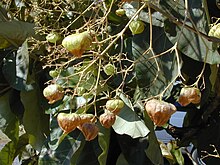| Teak | |
|---|---|

| |
| Teak foliage and fruits | |
| Scientific classification | |
| Kingdom: | Plantae |
| Clade: | Tracheophytes |
| Clade: | Angiosperms |
| Clade: | Eudicots |
| Clade: | Asterids |
| Order: | Lamiales |
| Family: | Lamiaceae |
| Genus: | Tectona |
| Species: | T. grandis
|
| Binomial name | |
| Tectona grandis | |
| Synonyms[2] | |
| |
Teak (Tectona grandis) is a tropical hardwood tree species in the family Lamiaceae. It is a large, deciduous tree that occurs in mixed hardwood forests. Tectona grandis has small, fragrant white flowers arranged in dense clusters (panicles) at the end of the branches. These flowers contain both types of reproductive organs (perfect flowers). The large, papery leaves of teak trees are often hairy on the lower surface. Teak wood has a leather-like smell when it is freshly milled and is particularly valued for its durability and water resistance. The wood is used for boat building, exterior construction, veneer, furniture, carving, turnings, and various small projects.[citation needed]
Tectona grandis is native to south and southeast Asia, mainly Bangladesh, India, Indonesia, Malaysia, Myanmar, Thailand, and Sri Lanka, but is naturalised and cultivated in many countries in Africa and the Caribbean. Myanmar's teak forests account for nearly half of the world's naturally occurring teak.[3] Molecular studies show that there are two centres of the genetic origin of teak: one in India and the other in Myanmar and Laos.[4][5]
- ^ Gua, B.; Pedersen, A.; Barstow, M. (2022). "Tectona grandis". IUCN Red List of Threatened Species. 2022: e.T62019830A62019832. doi:10.2305/IUCN.UK.2022-2.RLTS.T62019830A62019832.en. Retrieved 29 January 2023.
- ^ "Tectona grandis L.f." Plants of the World Online. Royal Botanic Gardens, Kew. Retrieved 20 July 2024.
- ^ William Feinberg (8 July 2013). "Burmese Teak: Turning a new leaf". East By South East. Retrieved 20 September 2015.
- ^ Verhaegen, D.; Fofana, Inza Jesus; Logossa, Zénor A; Ofori, Daniel (2010). "What is the genetic origin of teak (Tectona grandis L.) introduced in Africa and in Indonesia?" (PDF). Tree Genetics & Genomes. 6 (5): 717–733. doi:10.1007/s11295-010-0286-x. S2CID 11220716.
- ^ Vaishnaw, Vivek; Mohammad, Naseer; Wali, Syed Arif; Kumar, Randhir; Tripathi, Shashi Bhushan; Negi, Madan Singh; Ansari, Shamim Akhtar (2015). "AFLP markers for analysis of genetic diversity and structure of teak (Tectona grandis) in India". Canadian Journal of Forest Research. 45 (3): 297–306. doi:10.1139/cjfr-2014-0279.
